
FREE TOURIST GUIDE
TOURIST OFFICES
Claudia del Pino Martínez

Design: Eva Veiga Buide
Cartography: Samuel Nájera Bailón
Translation: Interlingua Traduccións SL
Photography: Antonio Paz, Mancomunidade de Concellos da Mariña Lucense [except, Iván Nespereira: pages: 5 b; 18 d; 24 b; 27 b.
Carlos Cornide: page 23 a.
Eduardo De Martís: page 24 a, c.].
Legal deposit: LU 145-2020
Summary Natural beauty spots Coast and beaches Cultural heritage Map Historical ensembles Industrial past Northern Way Nature-based activities Experiences Gastronomy Accommodation Fiestas and events 4 8 12 14 16 18 19 20 22 24 26 27
Concellos
Mariña Lucense Coordination and content writing:
Published by: Mancomunidade de
da
The aim of this tourist brochure is to introduce you to A Mariña Lucense and help you discover everything it offers to ensure you enjoy your stay here.
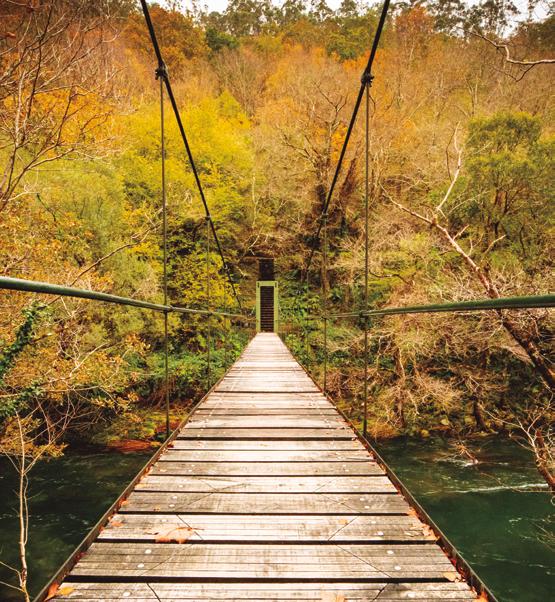
We would love you to get to know us and choose A Mariña Lucense as your destination.
Ours is a corner of the world bathed by the Cantabrian sea, in northern Galicia. A magical and tranquil place where the mountains and the sea merge to form wide, fertile valleys boasting treasures of nature and art. A true land of friendly people and outstanding gastronomy. A place where you will experience once again the beauty of travel.
The links provide access to detailed information in English and/or Spanish and to web sites.
amarinalucense.gal
Places of natural charm
This region offers a variety of very diverse charms. The beauty of the mountains, the tranquillity of a countryside criss-crossed by numerous rivers and the infinite horizon of the Cantabrian coast.


The coastal ranges provide unequalled vantage points and contain natural elements unique in Galicia, such as the peatlands of the Serra do Xistral (O Xistral mountain range). The land surrounding the rivers which shaped the rich valleys of A Mariña are home to remnants of autochthonous forest, and its estuaries boast a huge variety of fauna and vegetation. For its part, the coast reveals immense natural diversity and its relevant geomorphological resources lend the landscape a unique and extraordinary allure.
Proof of the value of the area’s natural
resources is their status as protected zones, where large expanses of land given over to forest farming (mainly eucalyptus) also exist. Renowned for being protected within the Natura 2000 network are the coasts of the Western Mariña and As Catedrais; the mountain ranges of Monte Maior and O Xistral; the rias of Ribadeo, Foz, Viveiro and O Vicedo-O Barqueiro; rivers Eo, Masma, Ouro and Landro and the “fraga” (autochthonous forest) of Carballido. Enclaves such as the Souto da Retorta and As Catedrais beach are natural landmarks.
Such a diverse context embraces a wide range of charming landscapes and spots where visitors can switch off and breathe in life.
Stretching across the interior of A Mariña
Lucense lies the “Serra do Xistral”, a mountainous massif separating the Cantabrian sea from the Terra Chá (Flat Land), made up of undulating mountains whose highest point is O Cadramón peak (1056 m). Though a wild landscape, it has been inhabited for centuries, and can be scaled in the space of just a few kilometres, from the gentlest low-lying countryside to heights that recall the Scottish Highlands.
SERRA DO XISTRAL
+INFO MAP
A protected space (SAC-Natura 2000 network), frequently windy and where mists and rainfall feed the rivers that flow into different basins, and home to abundant peatland, considered, along with the existing wet heaths, the most significant carbon pools in temperate Europe.
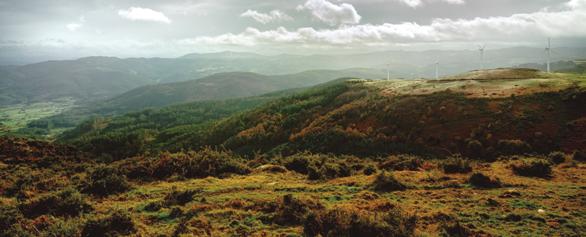
It is common to see horses and cows grazing freely on the higher parts of the mountains alongside giant wind turbines. Most of the population lives in the valleys below, given the harsh weather conditions the mountains endure.
To get to know the area, travel along the LUP-0101, which links O Valadouro with Abadín, or take a guided tour for a closer look.
COVA DO REI CINTOLO
This cave is to be found 15 minutes from Mondoñedo in an outstandingly beautiful natural environment near the hamlet of Supena. It is the largest cave in Galicia, measuring 6.5 km. A place of scientific and geological interest and a speleological point of reference in Galicia. Its limestone and slate composition has given rise to characteristic galleries with stalactites, stalagmites, columns, flowstones and gourdams. Visits by prior booking only. +info: 982 507 177

SOUTO
Also known as the “Chavín eucalyptus wood”, this Natural Landmark, situated in Viveiro, is home not only to giant 100-year-old eucalyptus trees but also to autochthonous forest species. Trees planted from 1880 onwards which have reached gigantic dimensions today, such as “O Avó” (the grandfather), 126 years old and 71.4 metres high, with a diameter of 7.6 m. Their function was to drain the land near the River Landro and prevent the frequent flooding that affected the industrial activity conducted in the area by the innovative businessman José Barro.

5
DA RETORTA
Mondoñedo Town Council regularly organises guided speleological tours.
A 7 km from Viveiro, Access is via the LU-161 yand there are car parking facilities.
PRAIA DAS CATEDRAIS
(Augas
Santas)
Within the protected 297-hectare coastal stretch (SAC-Natura 2000 network) is located As Catedrais beach, a Natural Landmark famous for its huge sculpted arches, some of which are 30 metres high and can be explored on the beach at low tide. Ribadeo Town Council offers guided tours around these natural wonders. Easy to access from the A-8 and the N- 634.
FUCIÑO DO PORCO (Punta Socastro)
Zigzagging along a wooden boardwalk, this rugged and spectacular spot, situated at the entrance to the Viveiro ria in O Vicedo, boasts pretty panoramic views of the Cantabrian coast. Access is signposted from the LU-862. Vehicles can be left at a designated parking facility from where visitors follow the Blue path from Abrela beach to the vantage point which is a 15-minute walk away.

In recent years, both of these spots have become increasingly popular, meaning that at peak holiday times it is advisable to book your visit beforehand.

ART IN NATURE
Espazo Caritel
Finca Galea
BOOK AS CATEDRAIS
The artwork of the renowned sculptor Daniel Caxigueiro, along with his passion for nature, resulted in this pretty botanical garden whose quantity and variety of plants from all over the world will surprise and delight visitors. Especially noteworthy are its camellia and hydrangea collections. The garden is situated opposite San Martiño de Mondoñedo Basilica (Foz).
+info : 982 132 694
This unique spot allows you to explore the world of water from an ethnographic and artistic perspective. An ideal place to stroll alongside the River Ouro and enjoy its different attractions, such as the working fulling mill, the lake, small canals or fossilised trees. The turnoff is signposted from the LU160, in A Seara (Alfoz) and is less than 1 km from there.
+info: 690 156 081
BOOK FUCIÑO DO PORCO
Galicia is, according to the writer from Mondoñedo Alvaro Cunquiero, the land of a thousand rivers. A Mariña Lucense is, without a doubt, no exception. The waters of its rivers, streams and brooks, combined with its rugged terrain, give rise to natural pools (“pozas”) and waterfalls (“fervenzas”) of a variety of shapes and sizes throughout the area.

A Mariña is home to more than ten waterfalls and natural pools scattered across the landscape, some hidden and others more accessible, and indeed some of which are suitable for swimming, but all of which are blessed with their own charm.








7
A Férrea, A Pontenova
A Fervenza, Mondoñedo
Salto do Coro, Mondoñedo
Escouridal, Alfoz-O Valadouro
Pozo da Onza, O Valadouro
Pozo da Ferida, Xove-Viveiro
Guilán, Xove
Xestosa, Ourol
+INFO
Santo Estevo do Ermo, Barreiros
Coast and beaches
Ideal places to relax and enjoy.
This green coastline stretches across more than 100 kilometres and – in contrast to the rest of Galicia – is defined by its relatively small rias and the succession of beaches and cliffs. A coastline of significant landscape value and a wealth of cultural heritage, full of opportunities to do sport and observe nature, for those who love swimming at great beaches and enjoy walks along endless coastal paths or wide sandy beaches..

Most of the population of A Mariña Lucense, numbering around 72,000, lives along this coastal stretch. The lives of its inhabitants are often closely linked to fishing, A Mariña boasting two of the most important fishing ports on the Cantabrian coast: Burela and Viveiro (Celeiro). Fish-farming and activities linked to forestry are also significant. In more recent times, tourism traditionally associated with sun and sand has been shifting towards slower, more relaxing and integral experiences, facilitated by the endless opportunities the area provides.
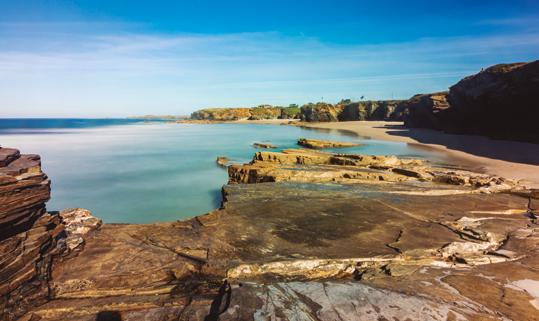
Seafaring culture




To better understand the world of the sea, as well as stopping at some of the ports and coastal towns, trying some of the delicious local gastronomy, we would also recommend visiting: the markets and fish markets in, for example, Celeiro (Viveiro) and Burela, which are bustling and colourful; lighthouses such as Illa Pancha (Ribadeo), Roncadoira (Xove), or Punta da Atalaia (San Cibrao), and other places which show off our seafaring culture to interested visitors. Such is the case of the Reina del Carmen museum ship, previously a tuna fishing vessel, and the women’s fishing nets workshop in Burela, or the Museo Provincial do Mar (Museum of the Sea) and the Francisco Fra artisanal shipyard, both of which are in San Cibrao (Cervo).
In the harbour area of the summer resort of Foz, in the traditional harbour of Rinlo (Ribadeo) or in the “Portiño” de Morás (Xove), visitors can enjoy picturesque nooks with a flavour of the sea.
Among the remnants of a local economy inextricably linked to the sea are the ruins of the San Cibrao and Caolín beach (O Vicedo) salting factories, the natural shellfish farms in Rinlo (Ribadeo) and the loading bays at A Insua (Viveiro) and Ribadeo. Also nearby is San Damián Fort, built in the 17th Century to defend the ria and its inhabitants.

9
Beaches

A Mariña Lucense’s vast array of white, sandy beaches and transparent water makes it almost impossible for visitors not to find a favourite spot. Indeed, there are more than sixty from which to choose, including some with amenities and therefore more suited to families, others more isolated and private, or vast stretches of sand made infinite at low tide. In the last year, 18 were designated Blue Flag beaches, in recognition of their safety conditions, amenities and water quality as well as the informative and environmental management actions carried out.
 This coastline boasts the warmest sea temperatures in Galicia.
This coastline boasts the warmest sea temperatures in Galicia.
You can travel along the coast in various ways: by car, some stretches of road hugging the sea, using secondary roads; by the narrow-gauge railway line (FEVE), with stunning views, running services between O Vicedo and Ribadeo; and another undoubtedly tempting option provided by the Cantabrian Sea Nature Trail, to delight walkers or cyclists alike.




+INFO
Cultural heritage
In the footsteps of the past.
Archaeological remains found in the area are proof that it has been populated since the Lower Palaeolithic (excavations have uncovered tools in Louselas - Ribadeo), and continuously from as far back as 10,000 or 8000 B.C.E. (end of the Upper Palaeolithic or Epipaleolithic). As time passed, some of these populations formed hill fort settlements (“castros”), which were scattered throughout the area. The structures of several castros suggest the influence of Romanisation.
The Santo Tomé dolmen (O Valadouro) or the A Roda lithic circle (Barreiros) bear witness to this prehistoric past. For a closer look at castro culture, you can visit the San Tirso archaeological site in Portocelo (Xove), which offers guided tours, Fazouro coastal castro (Foz), small and easy to access and see, and Zoñán castro (Mondoñedo), much larger and originating in the Late Bronze Age, with constructions still visible today and dating back to the 1st–5th Centuries C.E., also easily accessible.
In the Middle Ages (12th Century), Viveiro and Ribadeo developed as towns, and the transfer of the episcopal see to Vilamaior do Val de Brea converted it into the new city of Mondoñedo. Alongside the already well-established towns, new coastal settlements began to

To speak of history in A Mariña Lucense is to speak of Pedro Pardo de Cela (1425-1483), an important feudal lord in these lands, executed in Mondoñedo Cathedral square for rising up against the Catholic Monarchs. Grand Master of the Bishopric of Mondoñedo, mayor of Viveiro, landlord of jurisdictions, castles, fortresses and manors, who left an important cultural legacy in the form of tales, legends and monuments. Some of the places linked to his life were the inspiration for the Pardo de Cela Route, which includes the remains of A Frouseira Castle (Foz-Alfoz), Castro de Ouro Castle (Alfoz), San Salvador monastery in Lourenzá, San Martiño de Mondoñedo Basilica (Foz) and the cities of Viveiro and Mondoñedo.
The fictionalised audio guide to Alfoz will immerse you in the life and legacy of Pardo de Cela, with the help of its protagonists.
appear (San Cibrao, Burela and Foz), connected with the whaling trade and the exportation of wood and fish and importation of wine.
+INFO
SAN MARTIÑO DE MONDOÑEDO BASILICA (Foz)
Some 5 km. outside Foz stands this Romanesque landmark, built in 1075 under the tenure of the bishop Gonzalo Froilaz. An episcopal see since the year 864, it combined the Dioceses of Dume and Britonia until, in the 12th Century, the decision was made for it to be moved to Vilamaior do Val de Brea, which we know as Mondoñedo today. It is a National Monument, home to priceless cultural vestiges, among them, historiated capitals, the tombs of former bishops and paintings from the 12th and 17th Centuries, the former considered among the oldest still preserved from the Galician Romanesque. The old rectory is now home to the Interpretation Centre. Open to visitors and guided tours.

+info: 982 132 607
SAN SALVADOR MONASTERY (Vilanova de Lourenzá)
The old double monastery, founded by Count Osorio Gutiérrez in 969, reached its full splendour in the 17th century. The current Church of Santa María (18th Century) was the work of Friar Juan de Samos initially and finished by Fernando de Casas Nóvoa, the designer of the façade which is thought to have been an experiment for his most important work, the façade of the Obradoiro. It is home to: a Neoclassical altarpiece by Ventura Rodríguez, with images by Ferreiro; in the sacristy, an impressive Baroque reliquary; and in the chapel of Nosa Señora de Valdeflores, the famous sarcophagus of Count Osorio Gutiérrez (“Conde Santo”), a Paleo-Christian piece made in the French Aquitaine in the 12th Century. The monastery houses the Town Hall and the Centro de Interpretación da Faba (Faba Bean Interpretation Centre). Open to visitors and guided tours. +info: 982 121 006. The fortress of Tovar is just 5 km away.

CASTRO DE OURO CASTLE (Alfoz)
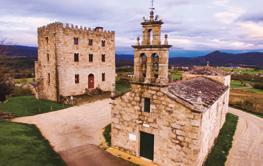
Rising up like a watchtower over the River Ouro valley, this emblematic landmark of Alfoz was occupied by Pardo de Cela in the 15th Century. Located on the site of an old castro (1st Century), the keep of the original fortress, linked to the founding of a family monastery in the 11th Century, has been preserved. Today, it houses a Tourist Information Office, exhibition room and museum. Beside the tower is San Salvador parish church, previously the Castle’s chapel. Finca Galea is just 1.1 km away.
+info : 982 558 578
13
A Mariña Lucese comprises a swathe of northern Lugo that stretches across the Cantabrian coast, between the Ribadeo and O Vicedo-O Barqueiro rias. Its boundaries are defined by the River Eo in the east, by the River Sor in the west and by O Xistral, Pousadoiro and Lourenzá mountain ranges in the south, inland. Each of its sixteen boroughs is attractive in its own right: Alfoz, Barreiros, Burela, Cervo, Foz, Lourenzá, Mondoñedo, Ourol, A Pontenova, Ribadeo, Riotorto, Trabada, O Valadouro, O Vicedo, Viveiro and Xove.

+INFO MAP

VIVEIRO
A historical city, surrounded by beautiful landscape, granting it a prime position on the estuary of the River Landro, which also enabled it to develop as a trading port. Today, it is a tourist hub of note, whose secluded squares and narrow streets maintain intact landmarks of considerable cultural heritage interest, such as the convent church of San Francisco, with pointed arches; Santa María Romanesque church; the Convent of the Conceptionists, or the Casa de los Leones. Also exceptional are the three doors of the six that the ancient wall once had: A Vila, O Valado, beside which the best preserved section of wall can be seen, and the Plateresque doorway of Carlos V (16th Century), situated opposite the bridge of Mercy. In the Town Hall Square, a statue pays tribute to the eminent politician and poet from Viveiro, Nicomedes Pastor Díaz.
MONDOÑEDO
An episcopal see since the 12th Century and ancient capital of one of the seven provinces of the old Kingdom of Galicia, Mondoñedo’s narrow stone streets are home to buildings of extraordinary historical and artistic value, whose maximum expression is to be found in the Cathedral Basilica of A Asunción (13th Century), declared by UNESCO a World Heritage Site along with the Northern Way of St. James, which passes through the city. Besides its many monuments, Mondoñedo boasts must-see places, such as the Barrio dos Muíños, where the tradesmen’s workshops were once located, or the Alameda dos Remedios (Os Remedios boulevard). Visitors can experience the cultural atmosphere of the Cathedral and the Cathedral and Diocesan Museum, the House-Museum of Álvaro Cunqueiro, the Printing Press
Interpretation Centre or the Interpretation Centre of Mondoñedo’s water supply systems
Since 2018, Mondoñedo has formed a part of Spain’s Most Beautiful Towns network.



Learn about these four Historical Ensembles by listening to A Mariña Lucense’s Fictionalised Audio Guides on your visits.

Must-see historical ensembles
RIBADEO
The vibrant and elegant streets of this historical centre, which overlooks the Ribadeo ria, are home to an interesting combination of construction styles that reveal the town’s prosperous past. The old houses of seafarers and tradesmen past sit alongside grand, traditional buildings that once belonged to rich gentlemen as well as a number of “casas indianas”, which lend the town its defining character. The Praza do Campo, or España, is the town’s main hub, accommodating the cosmopolitan Torre dos Moreno, the Neoclassical Pazo de Ibáñez, Santa Clara Convent and Santa María do Campo Church. The Old Customs House (18th Century), the Port, San Damián Castle (18th Century) or the “Cargadoiro” (loading bay) complete our tour of a town that offers visitors a variety of interesting options, including the following themed tours: “Indian” Ribadeo, Illustrated Ribadeo and Old Ribadeo
SARGADELOS
The Royal Sargadelos Factories, a historical industrial complex and benchmark of industrial tourism in Galicia, can be found in the borough of Cervo. It comprises the old steel foundries, the Administration House, a History Museum (+info: 982 107 654), the Old Earthenware Factory, the Weighing House, the damn and the canal – Paseo dos Namorados –, the Pazo de Ibáñez, the Royal Way, the Church of Santiago and the cemetery.

This business enterprise, which initially focused on iron smelting and later on earthenware and glass, was the brainchild of the enlightened entrepreneur Antonio Raimúndez Ibáñez (1709-1809). It ceased operations in 1875, only to enjoy a resurgence in the mid-20th Century under the guidance of Isaac Díaz Pardo and Luis Seoane who opened a new ceramics factory which remains today an icon of Galician culture, with its unmistakable, unique patterns.
The old stables are today home to the Centre of Enterprise and of Arts and Crafts. The Sargadelos Museum is located in the factory and offers guided tours. (+info: 982 557 841)


17
The landmarks of an industrial past
A Mariña Lucense’s landmarks are many and varied. Coupled with an extensive ecclesiastical and civil heritage is a significant industrial heritage, featuring not only the old natural fish farms, salting factories, weaving mills or electricity plants but also the Sargadelos earthenware factories and elements linked to the extraction, processing and transportation of iron, whose abundance in the area gave rise to Galicia’s two largest iron mines.
Of the A Silvarosa mines in Viveiro (1899-1969) the remains of the old A Insua loading bay have been restored. Remains of the chutes and the overhead tramway which was connected to the mine 5 km away. have also been preserved. For its part, in 1900 and in the River Eo basin, the Villaodrid Mining Company began to extract iron in two separate groups of mines: Vilaoudriz and Boulloso, each with their own set of calcining kilns. They closed down for good in 1966, but today a kiln from Boulloso and five from Vilaoudriz, in the centre of A Pontenova, have been restored and can be visited. Along with the mineral deposits and chutes, they are a testimony to its outstanding mining past. There are different options for visitors to learn more about this particular heritage. With the name “Zip line of the mines”, the Historical and recreational complex of the Consuelo and Boulloso mines provides guided visits to Consuelo mine and the adrenaline rush of a ride on a 300-metre-long zip-wire. (+info: 633 248 835). There is also a series of related itineraries, including the Railway route (Green Way). (+ info: 982 342 101)
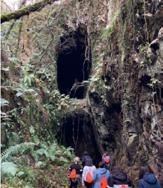

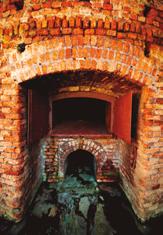
In the past, on the banks of the rivers Reigadas and Ferreiravella, blacksmiths’ forges, hammers and millstones proliferated. The Ruta “do Ferro” (Iron Route) is an 8 km trail which begins in As Rodrigas, the capital of Riotorto – shortened by starting in O Mazo – and gives visitors the opportunity to learn more about the heritage associated with iron processing, including the restored hammer of Fraga de Ferreiravella (visits: 982 161 677). You can also visit forges in the boroughs of Riotorto and A Pontenova and benefit from the first-hand knowledge of their “ferreiros” (blacksmiths) who keep the old, local tradition alive by hammering sickles and knives into shape (consult Craftsmen’s Routes).

In the final decades of the 19th Century and early 20th Century, we must mention the valuable legacy left by the “indianos” (emigrants who returned from the Americas having made their fortunres), from their grand, elegant houses to the different economic and sociocultural enterprises. In the boroughs of Ribadeo, Barreiros, Viveiro and Ourol visitors will see numerous examples of this heritage – also scattered throughout the destination –, a reflection of the significant emigratory flow that affected the area. In Ourol, the Indian Route takes visitors on a tour of this unique heritage.

The Northern Way of St. James

Making a pilgrimage to Santiago is for many a unique and transformative experience, a special way of getting to know both the places along the way and oneself.


The Northern Way of St. James, which passes through A Mariña, was declared a World Heritage Site in 2015 by virtue of its undoubted cultural value. It is as old as the French Way, chosen by European kings as a route to visit the Apostle’s tomb in the Middle Ages. It is currently the third most frequently used in terms of numbers of pilgrims, after the French and Portuguese Ways, respectively, and is relatively quiet, with some beautiful landscapes. It enters Galicia via Ribadeo, crossing the Os Santos bridge, to continue through Barreiros; or further south, through Trabada from Santiago de Abres. After passing through Lourenzá and Mondoñedo, the Way continues on towards Abadín, now in A Terra Chá, climbing steeply from the coast.
As well as a network of public hostels that already existed in Ribadeo, Trabada, Vilanova deLourenzá and Mondoñedo, in recent years some new ones have opened, improving accommodation options along the Way and allowing pilgrims to learn about our important ecclesiastic and civil heritage and discover the nooks and crannies of our landscape – made all the easier to discover on foot –, our delicious gastronomy and the genuine kindness of its people. ¡Buen Camino!
+INFO
In Mondoñedo you can visit the Northern Way Interpretation Centre.
Nature activities
The geographical diversity of this destination opens the door to a variety of activities to be enjoyed in the natural environment, from simply watching and discovering to dynamic alternatives for the most adventurous among us. The rias provide a natural shelter, perfect for the enjoyment of nautical sports all year round, and the accessibility and orientation of the beaches make it a perfect spot for surfing.
Nautical sports facilities, town councils, specialist guides and more than twenty companies devoted to sports and adventure activities provide numerous interesting options for beginners and experts alike.
Surfing, windsurfing, kitesurfing, paddle- boarding

Guided boat trips
Boat hire
Snorkelling and Diving

Canoe and kayak expeditions (routes/trips)

Water-skiing, wakeboarding
Trekking, trail running, BTT trails
Horse-riding
Caving
Paragliding
Canyoning
Rock climbing and rappelling
Recreational sea fishing and river fishing
Zip wire
Visits led by experts to places of cultural and natural heritage interest in the area and specific mycological, ornithological and geological trails.
ORNITHOLOGICAL TOURISM
A Mariña Lucense provides excellent sites for bird watching. The annual migration of thousands of sea birds can be observed from any of the numerous headlands, and especially well from Cabo Burela. Three places have been declared Special Protection Areas for Birds (SPAs), fundamental for the preservation of several species, as numerous waterfowl find shelter there on their migratory journeys or because they provide excellent breeding grounds.

The Coast of A Mariña Occidental provides shelter for colonies of sea birds, with an important population of ostrero euroasiático. The Foz ria is home to a varied community of waterfowl in winter and in the autumn migratory period: spoonbills, gulls, anatidae and waders. In the estuary, significant wintering populations of curlews and bar-tailed godwits gather. The Ribadeo ria is a resting place for water birds, especially for wintering Eurasian wigeons and northern pintails. Species of mountain birds that are scarce in Galicia breed in O Xistral mountain range, such as the citril finch, the Eurasian siskin and the red crossbill.
GEOTURISM
This destination is a must for geotourism lovers in Spain. The unique shapes of the coastline are a testimony to the evolution of the terrain resulting from the interaction of different factors, such as: the rocky substrate, the power of the waves, tidal phenomena, or the action of saltpetre on the rocks. Quartz, slate, shale, gneiss and granite are all predominant, often revealing large faults and folds, as can be seen in Burela, which boasts the best-preserved group of folds in Galicia. The erosion of these substrates and the transportation and deposit of sediments gave rise to the sea caves (“furnas”), blowholes (“ollos”), islands, islets and arches that are characteristic of this coastline and whose maximum expression can be seen at the As Catedrais beach.
Some borough councils, including Burela and Ribadeo, are pioneering in their promotion of geological routes to learn about the origin, formation and evolution of this region.

TREKKING
Because lacing up your boots and walking is the healthiest, most natural and rewarding way to understand the environment, we would encourage you to discover our walking trails, scattered throughout the region and offering a variety of different lengths, difficulties and landscapes. Trabada, O Vicedo and A Pontenova, have approved trails and in almost all of the boroughs there are options that allow walkers access to our autochthonous forests and riverside woods in mountain and coastal surroundings.
There are two Nature Trails in A Mariña: one belonging to the Cantabrian Route, covering a distance of 131 km along the entire coastline, which we recommend dividing up into 7 stages, and the San Rosendo trail, which links Mondoñedo to Foz, passing by San Martiño Basilica.
A MARIÑA TRAILS

21
Experiences
To enrich your life.
Being a relatively quiet destination brimming with personality has enabled A Mariña Lucense, along with the Ferrolterra–Rias Altas geo-destination to form a part of the Turismo Slow Norte de Galicia (Northern Galicia Slow Tourism) brand, which brings together people and businesses that advocate sustainable and socially responsible tourism, hosts that will be delighted to welcome you and facilitate your stay. A way of helping people get to know the area, its contrasts, the gastronomy, hidden places, natural landscapes, trails to wander and alternatives for enjoying the local customs.
A pleasant and novel way of inviting you to discover not only the most important heritage of A Mariña, but also its most hidden essence, its voice and the voices of its people, its stories and legends, its vibe and its memories, through the voices of narrators, dramatized scenes, interviews, music and sound maps. Audio guides are already available in the boroughs of Alfoz, Cervo, Foz, Lourenzá, Mondoñedo, Ribadeo and Viveiro and have been painstakingly produced by one of Spain’s most important theatre companies, Grupo Chévere. They are available in English, French, Galician and Spanish. To enjoy the fictionalised audio guides, all you have to do is download them, free of charge, and enjoy the show!
All of which are summarised in a web site – with a link on this page – which provides ideas that will enable you to enjoy a slow tourism experience in a destination that has it all.


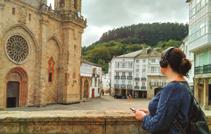
 SLOW TOURISM FICTIONALISED AUDIOGUIDES
SLOW TOURISM FICTIONALISED AUDIOGUIDES
Rutas de Artesanía da Mariña

Lucense
Some years ago, the important cultural legacy of our craftsmanship led us to create a dinamic project aimed at recuperating and promoting craftwork, shining the spotlight not only on the work itself but on the crafters, those magicians who use their knowledge to transform the raw material into objects that make our lives easier and adorn our homes.

The craftsmanship routes are culture-based tourist tours devised to help you visit the region from a slow and easy perspective, but imbibed with the knowledge necessary to capture its personality and diversity, where the crafters are the protagonists, enabling visitors to experience not only the stunning landscapes but also the workshops and artisanal trades, from the design stage to sale. An excellent way to venture into the heart of A Mariña.
Regal Cerámica Route
Fra Shipyards Route
Mondoñedo Crafters Route

Espazo Caritel Route
Raíces Nómadas Route
A Pontenova and Riotorto Blacksmiths Route
This project is available in the autumn and offers visitors a series of itineraries – 2 to 3 hours long and in the capable hands of professional guides and locals – during which they can learn about the natural and cultural values of the different boroughs, opening tiny windows to A Mariña Lucense’s most wonderful places.
CRAFTSMAN-SHIP ROUTES

23
ROUTES AROUND A MARIÑA
Gastronomy
The quality of our raw materials, together with tradition and the know-how of our chefs, are undoubtedly a magnificent advertisement for our gastronomy. Dishes shaped by the culture, history and economy of the region, offering visitors an unparalleled opportunity to bond with the land.
The coastal regions provide products such as line-caught hake from Celeiro – with its quality seal – or longfin tuna from Burela – caught using traditional methods –, goose barnacles from Rinlo, wedge clams and sea urchins, lobster, slipper lobster, spider crab, edible crab and octopus, among many other marine delights brought in with the daily catches from the Cantabrian sea, ensuring their freshness and quality.

Visitors can also try the excellent meats from the region’s many livestock farms, including Galician veal from the “Cachena” cow and celtic pork


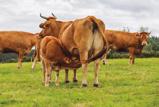
The climate and organoleptic conditions of the valley are perfect for creating products of renowned quality, such as the famous “Faba de Lourenzá”, with a Protected Geographical Indication, as well as other notable vegetable garden products: the verdina bean, tender turnip tops (grelos), tomatoes, leeks, spinach or lettuces, enabling producers to generate their own designation of origin trademarks, “Horta de Mondoñedo” or “Verdina de Galicia”.

Chestnuts, fungi and multi-floral honey are yet more of the local products that actively appear in our cuisine, as does flour, which helps make our renowned traditionally baked bread and “empanadas” (savoury pies), or signature dishes such as the “enfariñada ” from Tabada, also known as “faragullos” in A Pontenova. In pastries and confectionary, almonds are a star ingredient: Tarta de Mondoñedo, Colineta de Viveiro or Tarta de Riotorto. Home-made chocolate and typical seasonal sweets such as those made especially for Easter or Carnival make up the delicious range of products available from our bread and pastry shops.
Find restaurants:
+INFO
This route provides a unique experience involving art, nature and gastronomy in the surroundings of the fertile Lourenzá valley, stretching out across A Mariña Lucense in its entirety, a land whose climate conditions are ideal for growing this jewel in the crown of Galician legumes. Visitors will gain first-hand knowledge of traditional “faba” bean production, meeting producers on their farms, stopping at the Terras da Mariña Cooperative and the Faba Bean Interpretation Centre. They can also try the beans in combination with some of the region’s other top products and visit San Salvador Monastery, the Pazo de Tovar, O Muíño do Pereiro and the vantage point at A Valiña


This route includes a visit to the Pazo-Fortaleza de Tovar (Tovar Fortress and Manor), a stately, fortified mansion built in the Isabelline Gothic style by Antonio de Tovar around the tower of Canedo in the XV and which is home today to the Linen Museum, the Rincón do Xoguete Tradicional (Traditional Toy Corner) and a restaurant. + info: 676 922 389
This project extols the values of our local gastronomy, highlighting agro- food producers and products, disseminating video recipes created by professionals and organising an open competition featuring recipes made with products from the region. Its aim is to stimulate agro-food production based on local biodiversity and sustainable production. For further information on the project, please click on the link to the web site on this page and discover our recipes as well as the products and producers that make them possible.

25
COOKING A MARIÑA
FABA BEAN ROUTE
Accommodation
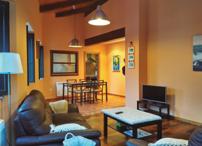
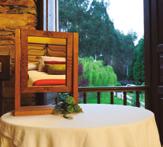

Ideal accommodation options.




A Mariña Lucense boasts a wide range of accommodation options, enabling you to find the ones that suit you best during your visit. Establishments that provide great value for money, ranging from hotels, B&Bs and rural cottages, for example, to publicly and privately run hostels, tourist apartments and campsites.
Along the coast, the options are many and varied, and inland you will also come across accommodation of all types, including rural tourism establishments spread across the region and other types of accommodation, centred mainly around the borough capitals. The Northern Way of St. James has a network of public and private hostels for pilgrims as well as ample accommodation options.

+INFO Find accommodation:
Fiestas and events




The cultural and recreational activities on offer in A Mariña Lucense are both intense and varied. While some festive dates are burnt into the regional calendar, at local level each borough has its own programme of events and weekly or fortnightly markets.
Fiestas, fairs, events and festivities throughout the year, featuring some related to gastronomy, more than a dozen fiestas that have been declared of tourist interest in Galicia, celebrations such as Holy Week in Viveiro, of International Tourist Interest or the Resurrection Fest
Among the Fiestas of Tourist Interest in Galicia, and in relation with gastronomy, the following are renowned: Longfin tuna Fair in Burela and the festivals of the faba bean in Lourenzá, the line-caught hake in Celeiro, the trout in A Pontenova and the sea urchin in Cervo. In relation with the world of horses, recognised fiestas include “Rapa das Bestas” (cutting of the manes) in Candaoso (Viveiro) or the well-known fairs of San Lucas in Mondoñedo, dating back more than 800 years. The different boroughs all have their own patron saints’ festivities, which are multitudinous and colourful, one of the most outstanding that has been declared of tourist interest being San Lorenzo, in Foz. “Romerías” (pilgrimages to the shrines of saints), such as Santa Cruz in Ribadeo or Naseiro in Viveiro, and fiestas such as the “Maruxaina” in San Cibrao, the popular Queimada (Galician alcoholic punch) in Cervo, the International Emigrants Fiesta in Barreiros, the “Romaxe das Cruces” fiesta in Ponte de Arante (Ribadeo) or the Medieval Market in Mondoñedo complete this wide and varied range of well-known propositions, among the infinity of events that exist. On a religious note, the most relevant are the celebrations of Holy Week in Mondoñedo and in Viveiro, the latter declared of International Tourist Interest.
For details of the full schedule of events, please see A Mariña Lucense Turismo web site and participate with us in these wonderful celebrations.

OF EVENTS
27
PROGRAMME


A Mariña Lucense Turismo

 A Mariña Lucense Turismo
A Mariña Lucense Turismo
ANNEXES
Natural spaces
Nine areas classified as Special Areas of Conservation (SACs) exist in A Mariña Lucense within the NATURA 2000 network protection area, distributed throughout the region. In addition, there are three Special Protection Areas for Birds (SPAs): coast of A Mariña Occidental, and the rias of Foz and Ribadeo (RAMSAR wetland site). Also protected, but in this case with Natural Landmark status, are Souto da Retorta in Viveiro and As Catedrais beach in Ribadeo.
Terras do Miño and Río Eo, Oscos and Serra do Burón Biosphere Reserves include extensive areas of A Mariña.
SPECIAL AREA OF CONSERVATION
Special Areas of Conservation (SACs) are areas of environmental interest, protected for the preservation of diversity and designated by the EU Member States to form a part of the Natura 2000 network, the most important commitment made by the European Union with regard to conservation matters.
SAC-Natura 2000 network AS CATEDRAIS
SAC-Natura 2000 network CARBALLIDO
SAC-Natura 2000 network MONTE MAIOR
SAC-Natura 2000 network RÍO EO
SAC-Natura 2000 network RÍO LANDRO
SAC-Natura 2000 network RÍO OURO
SAC-Natura 2000 network SERRA DO XISTRAL
SAC-Natura 2000 network RÍA DE FOZ-MASMA
SAC-Natura 2000 network COSTA DA MARIÑA OCCIDENTAL
SPECIAL PROTECTION AREAS FOR BIRDS
The Special Protection Areas for Birds (SPAs) are areas of environmental interest favourable for the conservation of both migratory and sedentary bird species and have been designated by the EU member states to form a part of the Natura 2000 network.
Special Protection Area for Birds (SPA) – Natura 2000 network
COSTA DA MARIÑA OCCIDENTAL
Special Protection Area for Birds (SPA) – Natura 2000 network RÍA DE FOZ
Special Protection Area for Birds (SPA) – Natura 2000 network RIBADEO
Wetland (RAMSAR) RÍA DO EO
You can find interesting information regarding birdwatching in Galicia, including this region, at the following link: Galicia birding
NATURAL LANDMARKS
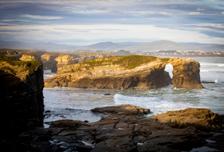



These are spaces protected by the Galician regional conservation regulations (Law 9 of 21 August) which defines such features as “spaces or elements of nature basically comprising notoriously unique, rare or beautiful formations which warrant special protection...”.
Natural landmark SOUTO DA RETORTA
Natural landmark AS CATEDRAIS
BIOSPHERE RESERVE
Defined as terrestrial or coastal/maritime ecosystems, where conservation of the biological resources coexists with the cultural, social and economic development of the local population, and which are recognised internationally in the framework of UNESCO’s Man and the Biosphere programme (MAB).
Biosphere reserve TERRAS DO MIÑO
Biospherereserve RÍO EO, OSCOS E TERRAS DE BURÓN


Waterfalls (“fervenzas”) in A Mariña Lucense

A Férrea, A Pontenova
A visit to the waterfall, 3 km from A Pontenova, is included in the A Férrea route, to be done on foot, or by car. Leave A Pontenova via the N-640 to Ribadeo and at the roundabout at the edge of the town, head towards the industrial park and take the main street right to the end, where the Recense warehouse is located. Turn left, following the signs for the route, and at the next crossroads, keep turning right until coming across a minor road leading to the start of the route, at the Torrentas bend. Nearby is a parking facility 300 m from the foot of the waterfall.


The Parada stream flows downhill with force, forming cascades and leaving foam and spray in its wake. The most important is A Cascada de A Férrea, which has two 8-metre drops, whose volumes change dramatically depending on the season.

Fervenza de Viloalle, Mondoñedo
Located 3 km outside Mondoñedo, this waterfall is signposted from the town. Take the LU-160 to Alfoz and, if going by car, take a turning on the left after approximately 2 km, cross the bridge and take the narrow track on the left for 300 m to a small parking facility. If going on foot, on the LU-160 there is an information panel (opposite a fountain), from where a path departs, leading to the waterfall via an attractive footbridge.
The River Tronceda, originating in the O Xistral mountain range and an affluent of the Masma, forms a series of fast-flowing cascades and pools. There is a recreation area with a natural pool surrounded by large rocks and eucalyptus trees, and a fresh water pool, as well as picnic area and a wooden bridge, called “Ponte dos Carabullos”. This spot is included in a route that pays tribute to the writer Leiras Pulpeiro, and an old electric power plant nearby is being restored.
Salto do Coro, Mondoñedo

Leaving Mondoñedo via the neighbourhood known as Os Muíños, take the DP-3102 in the direction of Cova do Rei Cintolo. After 2.4 km, there is a turn-off on the right. Take this narrow track for 1 km, after which you will have to continue on foot along a path that climbs steeply for 600 m. The waterfall is across a bridge and some steps. There is not much space to park and, therefore, we recommend walking from Mondoñedo, following the Ruta da Auga (Water Route) which starts at the Fonte Vella, in the town centre, or taking the same route as by car, watching out for the traffic, from Os Muíños (around 50 minutes).
As the Escourido “rego” (stream) flows through As Bouzas hills, it comes to a 10-metre drop, forming a small pool of crystal-clear water known as Salto do Coro. A magical place, reached on foot along a dirt, stone and wooden path and surrounded by autochthonous flora typical of a riverside landscape: ferns, lichens, moss, alders, hazel alders and walnut trees.
Escouridal, O Valadouro-Alfoz

Access to this waterfall is signposted. On the LU-160 leading out of Seara (capital of Alfoz), take the LU-CP-0202 at the traffic lights, towards the Casa do Concello” (Town Hall) and continue for approximately 8 km where it meets the LU-P-0204. Turn right, and after about 3.5 km, turn right at the turn-off marked Cadramón / Escouridal (DP-6360), and continue for a further 1.2 km to an information panel. A few metres further along, on the left, is a path with signs to follow on foot. Visitors can also park at this spot. The path ends with some wooden steps leading to the foot of the waterfall, which is easily visible. Those who want to get a little closer and see it in all its splendour can climb across some rocks with the help of a rope, being mindful of the danger.
The Escouridal waterfall is formed as the River Guilfonso (an affluent of the River Ouro) winds its way downwards over large granite rocks to plunge 80 m below. The best time of the year to see this spectacular waterfall is in spring, when the volume of water is at its highest, having collected the rainfall that has accumulated in O Xistral mountain range.

Pozo da Onza, O Valadouro
Leave Ferreira de Valadouro via the LU-162 to Burela, and 1.4 km after the roundabout, turn left onto the LU-P-1502 to “Ferreira”. 200 m further along is a sign for Pozo da Onza, on the right-hand side. Continue for a further 1.5 km (the road narrows at San Cristovo) until you reach a crossroads, where you turn left downhill for another 100 m. There is no specific area for parking, but it is possible to leave your car on the roadside. Continue on foot for 200 m along a signposted path, on the left bank of the river.
Pozo da Onza is a deafening waterfall in the borough of O Valadouro and the prettiest part of the Ruta dos Pozos (Route of the Pools). It forms in Val dos Infernos stream, which is an affluent of the River Ouro, is surrounded by quartzites camouflaged among the moss and ferns, and has a drop of some 15 m into a transparent pool.
Pozo da Ferida, Xove-Viveiro
Access to this waterfall is via the LU-P-2604 and it is signposted from Xove and Viveiro. It is situated approximately 12 km from Xove, following the LU-P-2604, and 14 km from Viveiro, taking first the LU-540 to Ourol/ Muras, then the turn-off for the LU-161 (Viveiro-Mondoñedo) and lastly the turn- off for Valcarría / A Ferida via the LU-P-6607 / LU-P-2604.



The turn-off from the LU-P-2604 is signposted, the route continuing along a surfaced track until it reaches a crossroads with a sign for the pool. Cars can be left here, and visitors can continue on foot for approximately 1.2 km (or a 20-minute walk), following the signs for the pool. The surfaced track becomes a dirt track and about 900 m along (a 15-minute walk), a path branches off to left, leading to the waterfall, a further 1.2 km (or 20-minute walk) away. At the end of the path, to the right, is an abandoned mill and a lovely natural pool formed by the river. 300 m along a path to the left is the waterfall, which drops vertically into the pool below.
The Pozo da Ferida is a waterfall situated between the boroughs of Xove and Viveiro. At this spot, the River Loureiro, a tributary of the Landro, is naturally channelled through the rocks before plunging into the circular pool below, surrounded by autochthonous vegetation, birches, alders, willows and oak trees, as well as some yew trees, holly and ferns. A beautiful place, shrouded in legend.
Fervenza de Guilán, Xove
Take the LU-P-2604 signposted at a crossroads on the LU862 in the centre of Xove. 600 m further along, having passed under the North Coast CG.2.3 road, on the right you will see a sign for the path to the waterfall, and have to leave your car here. The forest track crosses through eucalyptus plantations, parallel to the abovementioned North Coast road, and there are signs for the waterfall all along the 2-km walk, at which point it branches off to the left, the now stony path climbing quite steeply. The final turn comes after a 250-metre climb (as of November 2020, this is not signposted), beside a pylon, and the waterfall is 300 m from here.
There is a slightly shorter route to the waterfall, which starts in the industrial park but which is not currently signposted. In this case, take the LU-862 from Xove to Viveiro. Take the first turn-off on the left at km 94, just before Camba industrial park, follow the dirt track for around 1 km and, when it starts to climb, take the stone path on the right. A final turn-off to the right leads to the waterfall.
The Guilán stream flows gently downhill from its source until the area known as A Panda, where it becomes steeper. At this spot, the water plunges 70 m into the pool below, forming a beautiful, wide, foamy waterfall, especially in winter.
Fervenza da Xestosa, Ourol
Take the LU-540 from Ourol to Muros. 6 km from the centre of Ourol, take the turn-off signposted Chao da Roca / Xerdiz / Miñotos and continue along the old road. Before the bridge that passes over the LU540, you can leave your car at the small roadside rest area. Nearby, some 500 m further on the same road, is a sign for the waterfall, along a downhill path through a pine grove that leads to the foot of the waterfall.
A Xestosa waterfall takes its name from the River Xestosa - also known as the Xanceda - and is a tributary of the Landro. It has several cascades which end in a final 20-metre drop, the water thundering over the rocks, especially after periods of heavy rainfall.



Santo Estevo do Ermo, Barreiros
A 6.5 km circular route to be followed on foot starts at the Town Hall in Barreiros. By car or bicycle, take the turn-off on the N- 634 - 100m from the Town Hall - signposted “A Insua”. After some 800 m, the road meets the LP-1603, at which point, turn right, heading for Trabada, and continue for approximately 1.5 km until you come to a sign on the right, which is the final stretch, leading downwards along a sometimes uneven dirt and gravel track with deep groves left by the rainfall, until you reach a place where you can leave your car, although it is not, strictly speaking, a car park.
The Santo Estevo stream has a vertical drop of some 15 m and is situated in an area of significant natural beauty. Near the waterfall are to be found Santo Estevo do Ermo chapel, two “miraculous” fountains and a recreation area sensitively integrated in the surroundings, forming a beautiful spot of important ethnographic value.




In A Mariña Lucense other pretty cascades and waterfalls are dotted across the landscape, completing a wide range of naturally beautiful places, access to which is sometimes more complex on account of the lack of parking space, adequate signposting or the general upkeep of the paths and roads that take us there.

Places of considerable natural charm, such as, for example, the Fervenza de Torez situated in O Valadouro - to be found on the road from Ferreira do Valadouro to O Cadramón, with wooden signposts - and the Fervenza do río Lexoso in Ribadeo, included in the route called “Ruta do Encanto”, which has an information panel on the LU-133, from where the 200 m path to the river starts. There is no car park nearby. The Pozo das Moscas (O Valadouro), included in the Ruta dos Pozos, is also an appealing option. In this case, there is easy access to the pool. In the area known as Penas de Alaxe, follow the route between Tras os Ríos and A Portela for around 400 m until you come to a recreation area, from where a path branches off, bordering the river and leading to the pool around 200 m further along. Legend has it that on the feast of St. John, the “meigas” (witches) gather around the



We should not forget to mention the small waterfall on the Paseo dos Namorados in Sargadelos (Cervo), formed by the damn built in the 18th Century to supply water to the industrial plant. It is included in the “Ruta do Río Xunco”, which starts at the Praza do Souto in Cervo.
 Fervenza de Torez
Fervenza do río Lexoso
Pozo das Moscas
Paseo dos Namrados
Fervenza de Torez
Fervenza do río Lexoso
Pozo das Moscas
Paseo dos Namrados


A Mariña Lucense comprises a swathe of northern Lugo that stretches across the Cantabrian coast, between Ribadeo and O Vicedo-O Barqueiro rias. Its boundaries are defined by the River Eo in the east, by the River Sor in the west and by O Xistral, Pousadoiro and Lourenzá mountain ranges on the southern, interior boundary.
Each of its sixteen boroughs is attractive in its own right: Alfoz, Barreiros, Burela, Cervo, Foz, Lourenzá, Mondoñedo, Ourol, A Pontenova, Ribadeo, Riotorto, Trabada, O Valadouro, O Vicedo, Viveiro and Xove, spanning an area of 1462 km2, and bound by physical, human and economic ties, with a clearly defined coexistence between coast and interior. The region can be divided up into three main areas: A Mariña Occidental, A Mariña Central and A Mariña Oriental.
CLIMATE:
The influence of the coast creates a mild climate, with no great variations in temperature, making it an ideal place to visit all year round. For its part, the sea is the warmest in the whole of Galicia, averaging 20º C in summer.
HOW TO GET THERE:
To reach your destination, the nearest airports are Santiago-Rosalía de Castro, A Coruña and Asturias.
By road, the A-8 motorway and, running parallel, the N-634 road, A Mariña Central and Oriental directly to the rest of Green Spain in the north, while the southern area is linked to the central plateau and the Atlantic axis via the A-6 motorway. In the west, the LU-540 also provides access, as it links the A-8 via the AG-64 (Vilalba-Ferrol).
In order to move around within the region, the N-634 in the east and the N-642 and LU-862 in the west both link up the coastal cities. Visitors can also take the picturesque FEVE narrow- gauge railway from Ferrol to Gijón. Inland, a network of primary and secondary roads link the towns there among themselves and to the coast, making it easier to see all of the destination’s resources.
TOURIST INFORMATION:
A Mariña Lucense has a virtual tourist information space in the CENIMA buiding (Paseo da Ribeira, 1) and tourism management comes under the authority of the Mancomunidade de Municipios da Mariña Lucense, owner of the amarinalucense.gal website.
At borough level, below is a list of the official websites of all of the boroughs, or specific tourism websites, with interesting information on each borough.
Some of the town councils have Tourist Information Offices that are open all year round, while others might only open in the spring and summer seasons (normally between Easter and the end of summer). In the case of the seasonal offices, tourist information services are provided by a department in the Town Council offices, in the same way as occurs in the boroughs which have no separate tourist office.
Alfoz
Capital: A Seara - Population: 1585 inhabitants
Tourist office permanent. Castelo de Castro de Ouro, s/n. 27776. Alfoz. 982 558 578 - turismo@concellodealfoz.com
Barreiros
Capital: San Cosme de Barreiros - Population: 3020 inhabitants
Tourist office seasonal. Currently open to the public at Rúa Veiga, s/n. 27790. San Cosme. 982 124 002 - turismo@concellodebarreiros.gal
Burela
Capital: Burela - Population: 9430 inhabitants
Tourist office seasonal. Rúa do Porto, s/n. 27880. Burela.
982 888 506 / 982 58 60 00 - oficinadeturismo@burela.org
Cervo
Capital: Cervo - Population: 4192 inhabitants
Tourist office seasonal. Avenida da Mariña, 60. 27890. San Cibrao.
982 595 157- turismo@concellodecervo.com
Foz
Capital: Foz - Population: 10,118 inhabitants
Tourist office permanent. Av. da Ribeira, s/n. 27780. Foz.
982 132 426 - turismo@concellodefoz.es
Lourenzá
Capital: Vilanova de Lourenzá - Population: 2115 inhabitants
Tourist office permanent. Centro de Interpretación da Faba. 27760. Vilanova de Lourenzá. 982 121 006 - lourenzaturismo@outlook.es
Mondoñedo
Capital: Mondoñedo - Population: 3.503 inhabitants
Tourist office permanent. Praza da Catedral, s/n. 27740. Mondoñedo.
982 507 177 - turismo@concellomondonedo.es
Ourol
Capital: Ourol - Population: 999 inhabitants
982 559 109
A Pontenova
Capital: A Pontenova - Population: 2191 inhabitants
Tourist office permanent. Est. a Taramundi, 2. 27720. A Pontenova. 982 342 101 - turismo@concellodapontenova.org
Ribadeo
Capital: Ribadeo - Population: 9811 inhabitants
Tourist office permanent. R/ Dionisio Gamallo Fierros, 7. 27700. Ribadeo. 982 128 689 - turismo@ribadeo.org
Riotorto
Capital: As Rodrigas - Population: 1187 inhabitants
Information at: 982 346 222 (Riotorto Town Council)
Trabada
Capital: Trabada - Population: 1107 inhabitants
Tourist office. R/ Celso Currás López, 14-16. 27765. Trabada. 982 143 956 - oficinaturismo@trabada.gal - 982 143 956 (Trabada Town Council)
O Valadouro
Capital: Ferreira do Valadouro - Population: 1938 inhabitants
Tourist office seasonal. Avenida Deputación, 6 (Casa da Cultura). 27770 . Ferreira do Valadouro.
Information at: 982 571 516 (ext. 3) - turismo@valadouro.gal
O Vicedo
Capital: O Vicedo - Population: 1665 inhabitants
Tourist office seasonal. Travesía da Mariña, 57. 27860. O Vicedo.
Information at: 982 590 195 / 982 590 029 - turismovicedo@gmail.com
Viveiro
Capital: Viveiro - Population: 15,231 inhabitants
Tourist office permanent. Av. Ramón Canosa, 3. 27869. Viveiro. 982 560 879 - oficinaturismo@viveiro.es
Xove Capital: Xove - Population: 3352 inhabitants
Tourist office seasonal. Av. Deputación, s/n. 27870. Xove. 982 592 632 - 982 592 001 - oficinaturismoxove@gmail.com
The data on population correspond to the official population figures resulting from the revision of the municipal population census as of 1 January 2022, provided by the National Statistics Institute.
Northern Way of St. James
The Northern Way of St. James, declared a World Heritage Site in 2015, crosses into Galicia at two points: Ribadeo, after passing through La Caridad (Asturias), and, further south, the borough of Trabada, from Santiago de Abres, also on the way from La Caridad and passing through Vegadeo. In both cases, the ways meet in Mondoñedo to continue towards Abadín.

Depending on the distance pilgrims want to and can cover, and the availability of accommodation, A Mariña Lucense can normally be crossed in two or three stages, if travelling on foot.
The route is signposted with a ceramic plaque displaying a scallop shell which complements the typical yellow arrow signposting. In Galicia’s historical towns, bronze scallop shells are placed directly on the ground
Pilgrims can stay at any of the state-run hostels along the Way, situated in Ribadeo, Trabada, Lourenzá and Mondoñedo: https://www.caminodesantiago.gal/es/durante-el-camino/ red-publica-de-albergues
For information relating to COVID-19 in the Autonoumous Region of Galicia, please go to: https://coronavirus.sergas.es
VIA RIBADEO:
RIBADEO: a pretty, historical, commercial town, also reliant on the services sector, with a wide range of accommodation establishments besides the state-run hostel. The distance between Ribadeo and Santiago, along the Way, is 190.7 km.
The Way leaves Ribadeo heading for Ove and Vilela and, after leaving behind the parish of San Pedro de Arante, home to Nosa Señora das Virtudes sanctuary, with some pretty late Roman frescos, it enters the borough of Barreiros via Vilamartín Pequeno, Vilamartín Grande, Gondán and San Xusto. Some pilgrims travelling on foot choose to stop in some of these villages that offer accommodation; others continue to VILANOVA DE LOURENZÁ, with its grand San Salvador monastery and the pretty Santa María church. The town offers both state-run and private hostels, as well as a varied range of services.
The Way continues via MONDOÑEDO, a small, historical and monumental city with a fine Cathedral and a wide range of services on offer. The pilgrimage route continues from here to Abadín, in the Terra Chá, as seen in the map below.

Ribadeo - Vilanova de Lourenzá: 28 km
Vilanova de Lourenzá - Abadín: 21.8 km
Ribadeo - Gondán: 20.9 km
Gondán - Mondoñedo: 15.6 km
VIA TRABADA:
In the past, pilgrims who wanted to avoid crossing the river by raft chose to enter Galicia by going around the ria of Ribadeo, following what is known today as the Historical Way. From Vegadeo, after crossing the bridge at Santiago de Abres (Asturias), pilgrims would head towards TRABADA, 19 km away. San Xiao municipal pilgrims’ hostel is to be found in Trabada, specifically in the neighbourhood known as Igrexa, in the parish of Sante. Some other services related to the Way are also available here.
From Trabada, departing via Trapa, pilgrims next come to Santo Tomé de Lourenzá – with a range of services on offer – and from there the Way continues towards Mondoñedo, crossing over two hills. They enter the city by crossing the historical Ponte do Pasatempo, in the neighbourhood of Os Muíños, leading to the cathedral.
The Way continues through MONDOÑEDO, a pretty, historical and monumental town with a fine-looking cathedral and a wide range of services on offer. The pilgrims’ way continues from
Vegadeo - Trabada: 19 km
Trabada - Mondoñedo: 19.2 km
FROM MONDOÑEDO:
From Mondoñedo, the Way heads towards ABADÍN (Terra Chá). Pilgrims can choose between two routes: The Official Way, via A Infesta or the complementary official Way, which passes through Maariz and Lousada. Both are well signposted and pass through some pretty landscapes, although there is a certain level of difficulty, due to the climb from Mondoñedo (140 m above sea level) to Abadín (560 m above sea level).
The Way that passes through A Infesta leaves Mondoñedo via the baroque Os Remedios church. This route is shorter, but quite difficult, and lacks services.
The complementary Way, which leaves via the Fonte Vella and the Praza da Catedral, is longer, but entails fewer difficulties, as it climbs less steeply, provides some services and is surfaced for most of the route.
By bicycle, from Mondoñedo, pilgrims are advised to use the complementary Way (road to Maariz) until it reaches the N-634.
Mondoñedo – Abadín via Lousada (complementary Way): 16.6 km
Mondoñedo – Abadín via A Infesta: 12.2 km



























 This coastline boasts the warmest sea temperatures in Galicia.
This coastline boasts the warmest sea temperatures in Galicia.



































 SLOW TOURISM FICTIONALISED AUDIOGUIDES
SLOW TOURISM FICTIONALISED AUDIOGUIDES























































 Fervenza de Torez
Fervenza do río Lexoso
Pozo das Moscas
Paseo dos Namrados
Fervenza de Torez
Fervenza do río Lexoso
Pozo das Moscas
Paseo dos Namrados



